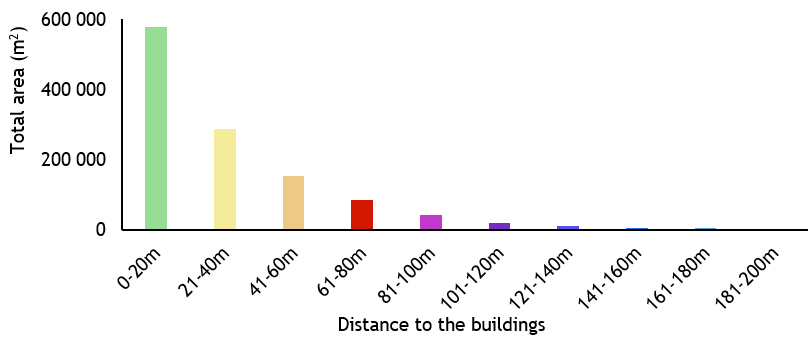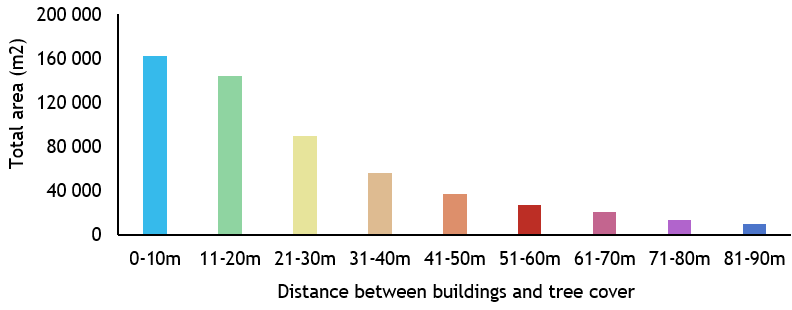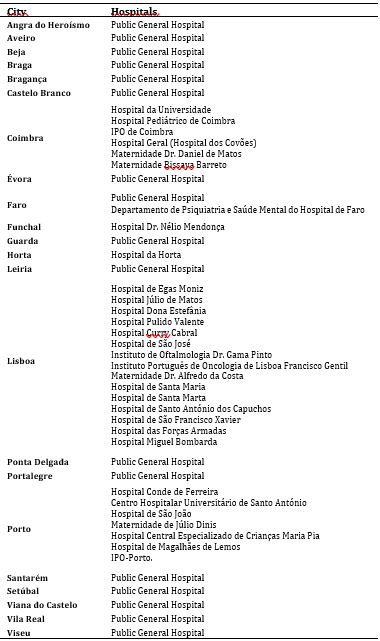Introduction
Therapeutic/healing gardens
Therapeutic Garden (TG) or Healing Garden are two terms found often in the literature to describe one, or a combination of improvements to wellbeing (Marcus & Barnes, 1999). A TG consists of a space intended to assist the mental and physical healing of patients in health units, and can be built outdoors, or in sunrooms and atriums of hospitals, but can also be intended for the general population and be built in public spaces, also having social benefits (Jiang, 2014; Pimentel, 2023). Given the possibility of the term having different meanings between different cultures, Jiang (2014) studied the use of the terms therapeutic landscape and healing garden in China and western countries, but concluded that in both cultures mean the same.
The ancient history of TG is believed to date back to ancient Greece and Rome, however, it is during the Middle Ages that more references appear (Marcus & Sachs, 2013). In fact, also in Europe, the first TG appeared in the Middle Ages, when monasteries and hospitals cared for the ill, the infirm and the insane and had an arcaded courtyard that residents could visit (Marcus & Barnes, 1999). In the following centuries it is also possible to find references to this type of green spaces, until the vision of nature as an intrinsic part of the healing process was lost during the twentieth century (Marcus & Sachs, 2013). Nowadays, this issue is back on the agenda and the importance of green spaces for healing purposes has been studied for different purposes, and in different areas.
Authors have been mentioning several benefits provided by green spaces, such as stimulating positive emotions (Lee et al., 2019; Liu et al., 2021; Zhang et al., 2023), which may be more important the more susceptible we are to negative emotions, for example when we are hospitalized. Even in a severe event such as the COVID-19 pandemic, green spaces proved to be important in mitigating stressful experiences (Kanelli et al., 2023). Thus, TG assist patients’ mental recovery and accelerate holistic healing (Dushkova & Ignatieva, 2020; Hastuti & Lorica, 2020; Jiang, 2014; Uwajeh et al., 2019).
As the mental effect of TG is widely recognized, it has also been evaluated for various psychological illnesses. These are the cases of Alzheimer's disease and dementia, in which patients can benefit from physical, psychological, social and cognitive effects (Murroni et al., 2021; Uwajeh et al., 2019) or patients with depression whose sleep quality has improved (Yeon et al., 2023). When patients are in a TG, perception, memory, emotion, planning, language and social intelligence are stimulated by encounters with plants and art (Yzoard et al., 2017). In a green space, people also feel less emotional distress and pain compared to those inside the hospital, and their quality of life improves (Hastuti & Lorica, 2020; Sherman et al., 2005).
TG also benefits mothers by reducing stress and, furthermore, children born in a better hospital environment will be more likely to be healthier and happier individuals (Browning & Lee, 2011). In addition, they are not only effective for patients, but also provide benefits to patients' families and employees (Bernez et al., 2018; Jiang et al., 2018; Pimentel, 2023; Reeve et al., 2017). For example, Bernez et al. (2018) found that burnout is less present in nurses and caregivers who work in a space with a garden.
However, to make the most of these benefits, there are some features to take into account when designing a TG, so that the space is effectively therapeutic (Pimentel, 2023). Examples of these include quietness, comfortability, to be visible and have a good soundscape quality, for example natural sounds such as birds and water, as these sounds are significant for psychological stress relief (Guo et al., 2022; Hastuti & Lorica, 2020). The selection of plants is also fundamental, as they must stimulate the senses, creativity and memory, and must also be chosen according to the desired purpose and placed in the direction of the desired effect, all factors necessary to achieve the success of the TG (Arslan et al., 2018). Given the characteristics required for these spaces, aromatic plants are an option (Arslan et al., 2018). Also, high levels of green coverage (made up of 70% plant elements, in order to guarantee the predominance of the green colour) and hierarchical landscape realms on a hospital campus improve people-nature interactions, as well as it is also important to block noise pollution, through increased vegetation density or otherwise, so that the garden can provide tranquillity (Alkaisi et al., 2021). To achieve this, trees can be an essential element to introduce into TG (Defrance et al., 2019; Karbalaei et al., 2015).
Accessibility, seating areas and strategic location of green spaces are also key features for TG (Hastuti & Lorica, 2020; Jiang et al., 2018; Reeve et al., 2017). In fact, although several hospitals have green spaces just for viewing, that is, it is not possible to visit them, direct contact with nature combined with socialization is beneficial for mental health (relieving stress and stress-related mental disorders, anxiety and depression) (Chen et al., 2021; Song & Lin, 2022). Even a virtual visit has positive outcomes for Alzheimer’s Disease and dementia patients (Uwajeh et al., 2019). Furthermore, the possibility of using the space is also useful for carrying out therapeutic activities and, in turn, stimulating the necessary social communication (Jiang, 2014). Sherman et al. (2005), in their study, also found that the largest garden with the most direct access, was the most used.
TG must also be designed according to the intended users. For example, while in older adults care centres the focus may be on reducing stress and promoting peace (Ilkhan et al., 2022), in paediatric hospitals it is also important that there are spaces to play in the TG (Reeve et al., 2017). Additionally, children interact with garden elements more than adults (Sherman et al., 2005) and the quality of a garden design in a paediatric hospital can influence their physical activity (Pasha & Shepley, 2013).
Given all the particularities required for a green space to be “therapeutic”, its certification could be important, in order to guarantee its effectiveness and prevent some green spaces from being falsely designated as “therapeutic”, which has been proposed (Marcus, 2016; Pimentel, 2023).
Trees and health
Trees are structural in green spaces due to their size and are responsible for providing shade where users can rest, allowing them to remain in the garden on hotter days. Deciduous trees create a visual dynamic by changing the colour of their leaves, providing shade during the summer, and letting in some sun in the winter when it is most needed, whilst evergreen trees create a constant barrier that can act visually or acoustically and provide year-round shade if required. Notwithstanding, Relf (2005) found that when trees were in leaf, they could provide more positive effects. The combination of deciduous and evergreen trees brings the opportunity to design the space to perform at its best. Trees have also a great impact on human vision, for example, they are used by Landscape Architects to create visual lines and guide vision. In addition to the scenic functions, it has also been found that seasonal changes in colour also create positive and intense emotions in patients and so, for example, the introduction of deciduous trees is advisable in healing gardens for patients with psychotic disorders (Paraskevopoulou et al., 2018). Apart from its seasonality, just the fact that a tree is in your line of sight can be beneficial. For example, Pearson et al. (2023) found that exposure in the classroom, especially to trees, could benefit children's mental health and therefore advise introducing trees in places that can be seen from classrooms.
In fact, trees are also important for mental health. Alvarado et al. (2023), in a study on street trees, found that they can reduce damage, provide mental restoration and even develop mental capabilities. More tree canopy is associated with less psychological distress for residents (Feng et al., 2022). Even during maintenance work, contact with green can trigger positive emotions and provide a better quality of life, while negative emotions decrease considerably (Joung et al., 2022). Actually, in addition to the maintenance work provides a positive mental effect (Joung et al., 2022), maintenance is also crucial to ensure its efficiency, since the health of street trees and the availability of adequate resources for their maintenance influence the beneficial effects that trees can supply (Alvarado et al., 2023). Furthermore, it has been suggested that the positive mental effect provided by tree canopy cover can be, in fact, powerful, as it may even prevent suicide attempts (Lee et al., 2023).
The presence of trees in the urban space is beneficial and several of their advantages are widely recognized. For example, trees improve air quality by removing air pollutants such as particulate matter (Gaglio et al., 2022; Rodríguez-Santamaría et al., 2022; Zhang et al., 2020), mitigate the urban heat by providing a cooling effect (Sharmin et al., 2023; Winbourne et al., 2020; Yan et al., 2023) and promote health and wellbeing (Astell-Burt et al., 2023; Marselle et al., 2020; O’Brien et al., 2019).
So urban residents can take advantage from these benefits, proximity to trees is important, especially for individuals on deprived and vulnerable groups (Baró et al., 2019; Bernatzky, 1977; Marselle et al., 2020). However, studies have revealed disparities in tree cover in cities, which negatively affect the potential benefits, creating environmental injustice (Endreny et al., 2020; Kolosna & Spurlock, 2019; McDonald et al., 2021). This environmental injustice mainly affects poor neighbourhoods and is not limited to the smaller presence of trees in these places, but also to their lower quality, which, in turn, as earlier mentioned, affects the beneficial mental effect that they can provide (Alvarado et al., 2023; Anderson et al, 2023; Fang et al., 2023).
Street trees also perform other essential functions for human life. For example, Zhu et al. (2022) found that trees should have a positive outcome on pedestrian safety despite, ironically, in the past, they have been removed as they were considered dangerous on the road. Notwithstanding, the presence of street trees in cities is not only favourable for humans, as they also augment species richness (Anderson et al, 2023).
Aims
This article aims to contribute to evaluating the viability of converting the current green spaces and permeable areas of 48 public hospital campuses into TG. There were assessed 1) the current usability, that is, whether the current gardens have structures that allow their use, such as paths or whether these structures need to be constructed; 2) the tree cover and its location (in green spaces or in impermeable areas), as it is structural and performs crucial functions; 3) the proximity of green space/permeable area and tree cover to hospital buildings, in order to assess whether they are at a distance from which possible future TG can be accessed easily.
Case study
In this article we have studied 48 public hospitals (hospitals in close collaboration with the National Health Service were also included). The studied hospitals are distributed across 22 cities in Portugal, these being the most important in each region (fig. 1). Normally, each city has a single hospital campus, but there are cities, for example the most important cities in the country (Lisbon and Porto), which have more than one hospital campus (appendix I). This is also the case of Coimbra, a city historically linked to university medical education, and Faro, in the south of the country, where the psychiatric hospital has its own campus.
In addition to hospitals on the mainland, this study also includes those located in the archipelagos of Madeira (three islands and two islets, but mainly known for the islands of Madeira and Porto Santo) and Azores (nine islands). Notwithstanding, one public hospital was studied in Madeira, located in the city of Funchal, and three in the Azores, located in Horta, Angra do Heroísmo and Ponta Delgada.
The urban-environmental context of the hospitals studied also varies. It is possible to find hospital campuses in consolidated urban areas, such as the public hospitals in Faro and Beja, as well as several in the largest cities, Lisbon and Porto, with no or little chance of horizontal growth. However, it is also possible to find situations, such as the Hospital Pediátrico de Coimbra and the public hospital in Vila Real, which have peripheral locations and, therefore, greater chances of having horizontal growth.
According to the Koppen-Geiger classification, Portugal mainland is characterized by having a csb climate (warm-summer Mediterranean climate), especially in the northern part of the country and coastal areas, which gradually changes to csa (hot-summer Mediterranean climate) as we move south and inland (Agencia Estatal de Metereologia de España [AEMET] & Instituto de Metereologia de Portugal [IM], 2011). It is also important to mention that there is also a small region in the area of the city of Beja, classified as BSk (cold semi-arid climate) (AEMET & IM, 2011).
In the Madeira archipelago, the island of Madeira is mostly classified as having a csb climate, while Porto Santo has a predominant BSh (hot semi-arid climate) climate (AEMET & IM, 2012). In turn, the Azores archipelago presents a predominant Cfb climate (oceanic climate) in almost all of its islands, with the exception of the islands of Santa Maria and Graciosa, which present a predominance of csb and csa in most of their territory (AEMET & IM, 2012).
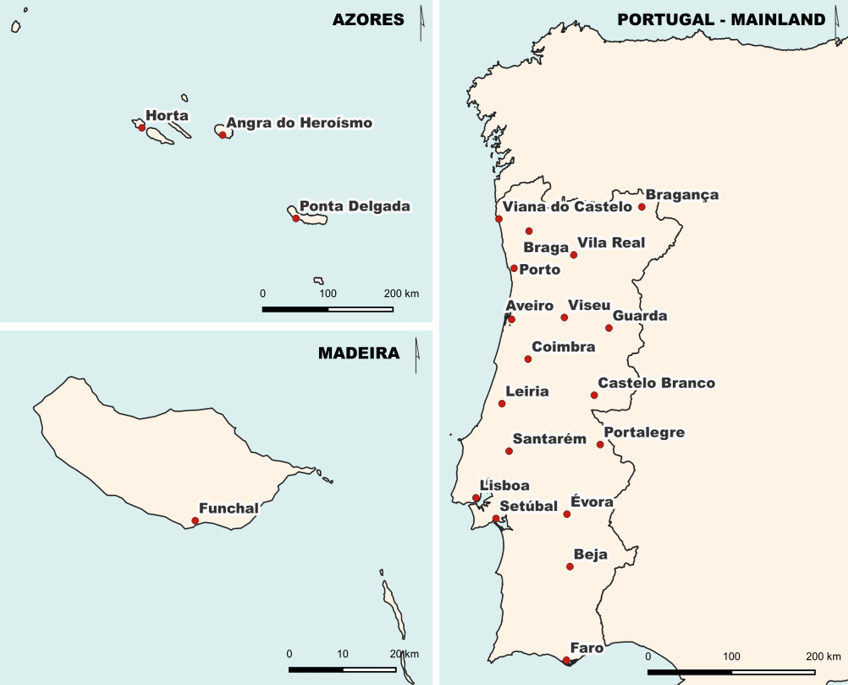
Fig. 1 Studied cities. Background data: © EuroGeographics for the administrative boundaries; CAOP (Official Administrative Map of Portugal) 2021.
In economic terms, data from 2019 indicated that the purchasing power per capita of the cities studied varied between 90.70 (Horta) and 205.62 (Lisbon) (Statistics Portugal, 2020). Other cities with low purchasing power per capita (<100) are Angra do Heroísmo, Bragança, Castelo Branco, Guarda, Viana do Castelo, Vila Real and Viseu, while after Lisbon, the second city with the highest purchasing power per capita is Porto (154.02) (Statistics Portugal, 2020).
Methodology
This study aims to contribute to the assessment of the conversion of current green spaces and permeable areas in 48 public hospital campuses into TG. For this, three factors were analysed. Firstly, the current usability of green spaces on hospital campuses was verified, in order to assess whether the existing green spaces have structures, furniture, etc. that allow their use or whether it is necessary to construct them. This is a factor that may facilitate the conversion of current green spaces into TG and reduce construction costs, thus encouraging decision makers to do so. Secondly, we analysed the distance from hospital buildings to these green spaces, as direct access is required by the TG. Therefore, even with the appropriate equipment and conditions, if a green space is far from hospital buildings, it will not be suitable to be converted into TG. Lastly, as trees are structural elements of a green space, we also examined the tree cover present in these green spaces. This will allow us to understand whether we can have more mature green spaces that can quickly meet the TG requirements, or whether immediate conversion is not possible. To proceed to these analyses, a common Geographic Information System (GIS) was set up and used.
Data collection and vectorization
All green spaces inside the public hospital campuses were manually vectorized. Permeable (for example bare soil) and impermeable areas (examples of which are pavements and areas occupied by buildings) were also vectorized. The inventory was conducted using Google Satellite images©, accessed through QuickMapServices© for QGis©. Notwithstanding, the boundary of each campus was identified on Google Maps© and manually corrected when necessary.
Subsequently, green spaces were classified into: usable and not usable. Usable green spaces are those in which there are paths, seating areas, that is, which can be accessed and used directly. In turn, not usable green spaces are those that perform ecological and visual functions but cannot be accessed by people (except for maintenance purposes).
Tree cover was manually vectorized into a separate shapefile, and includes all trees within hospital campuses, even isolated ones. Data quality (completeness and consistency) was ensured through topological checks.
Calculus and analysis
All measurements were performed in the Geographic Information System. For percentage, the area of the respective hospital campus was considered as the total area. To evaluate the distribution of tree cover, the projected area of tree cover present in green spaces and other permeable areas, as well as in impermeable areas were obtained through an intersection process.
To analyse the distance from buildings to green spaces/permeable areas and to tree cover, a multiple ring buffer was created, taking as starting point the buildings polygons. Subsequently, it was intersected with the respective shapefile to obtain the area present in each distance interval.
Results
Usability of hospital green spaces
The percentage of usable green area on public hospital campuses, that is, whether a green space can be accessed by patients, family members and employees, or not, is shown in figure 2.
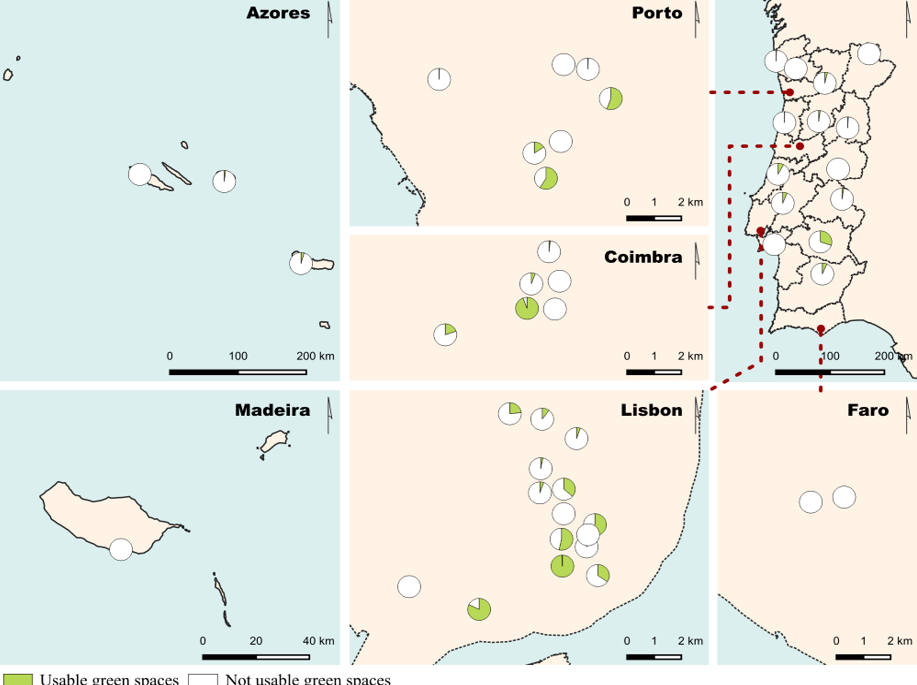
Fig. 2 Usable green area (%) per public hospital campus. Background data: © EuroGeographics for the administrative boundaries; CAOP (Official Administrative Map of Portugal) 2021.
Not usable green spaces, that is, hospital green spaces with only ecological and visual functions that cannot be accessed are dominant in most hospitals. In total, only seven hospitals have more usable than not usable green space. Four of them are located in Lisbon (Hospital de Santa Marta, Instituto de Oftalmologia Dr. Gama Pinto, Hospital de D. Estefânia and Hospital de Egas Moniz), two in Porto (Hospital Geral de Santo António and Hospital Conde de Ferreira) and one in Coimbra (Maternidade Dr. Bissaya Barreto), being the Hospital de Egas Moniz and the Maternidade Dr. Bissaya Barreto where the percentage of usable green spaces is higher.
In contrast, there are 15 hospital campuses where there are no usable green spaces, that is, in these hospitals all green spaces can only be observed, but not visited. It should also be noted that although not all campuses have usable green spaces, all without exception have green spaces just for viewing.
Among the 33 hospital campuses that have usable green spaces, 21 are located in Lisbon, Porto and Coimbra, remembering that Lisbon and Porto are the most important cities in Portugal and consequently suffer from greater urban pressure.
Distance from hospital green spaces to hospital buildings
Figure 3 and 4 shows the area of green spaces according to the distance classes from hospital buildings, up to a maximum distance of 200m.
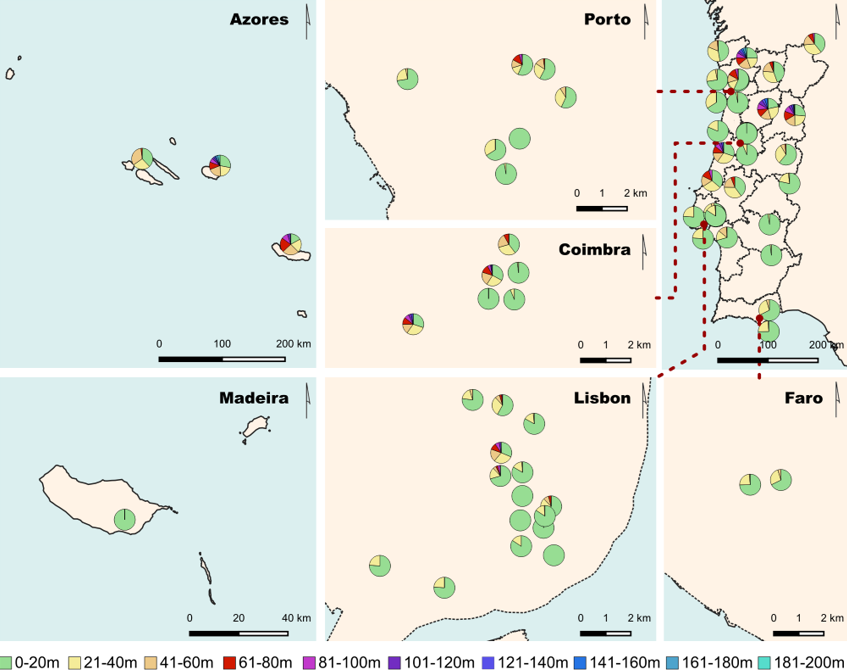
Fig. 3 Area of green space (% and m²) according to the distance measured from the buildings per public hospital campus. Background data: © EuroGeographics for the administrative boundaries; CAOP (Official Administrative Map of Portugal) 2021.
Most of the total area of green space available on the hospital campuses studied is located within 20m, followed by those located between 21-40m and those located between 41-60m. Even looking individually at the hospital campuses, it is noted that most of them, in fact, have a large part of the area of green spaces between 0-20m, with some exceptions in which the area of green spaces is more distributed over different distances, such as the public hospital campuses of Viseu, Guarda, Ponta Delgada and Angra do Heroísmo.
Notwithstanding, it is also noted that in some hospitals, the area of green spaces between 21- 40m is also significant, as well as, eventually, the area of green spaces between 41-60m. On the contrary, hospital campuses that have green areas relatively far from the buildings are rare, for example, only four hospital campuses have them more than 161m and only three have them more than 181m.
Tree cover on hospital campuses
Figure 5 shows the percentage of tree cover in all hospital campuses studied, represented by size and colour.
The highest tree cover values found were recorded in Porto, namely at the Hospital Conde de Ferreira (38.46%) and the Hospital de Magalhães Lemos (36.42%). Notwithstanding, the other hospital campuses in the city have low green coverage values, with the Hospital Central Especializado de Crianças Maria Pia being one of those with the lowest tree coverage (0.83%) in the entire study, only being surpassed by the IPO Coimbra (0.26%) which has the lowest tree cover found.
The low tree cover extends, in general, throughout the country, with island regions, the archipelagos of Madeira and the Azores, standing out due to their low values. Compared to the rest of the country, Lisbon has a concentration of slightly higher values, but still low values. There are only 4 hospital campuses with tree coverage between 31-40% and one of them is located in Vila Real (31%), a city located in the centre north of the country, which draws attention precisely because of its relatively high value when compared to the surrounding ones.
The percentage of trees that are located in green spaces and those that are located in impermeable areas is shown in figure 6.
Tree cover, on most hospital campuses, is located in green spaces. However, there are also hospitals where most of the tree cover is located on impermeable surfaces, such as the hospitals in Setúbal and Évora or the Hospital de São José (Lisbon) and the Hospital Central Especializado de Crianças Maria Pia (Porto). Furthermore, in all the hospitals studied without exception, it was found that there is tree cover in green spaces and impermeable areas, with no total in just one of the typologies. Tree cover within green spaces or permeable areas varies from the Centro Hospitalar do Funchal (Madeira) (18.20%) to the Maternidade Dr. Bissaya Barreto (Coimbra) (96.48%).
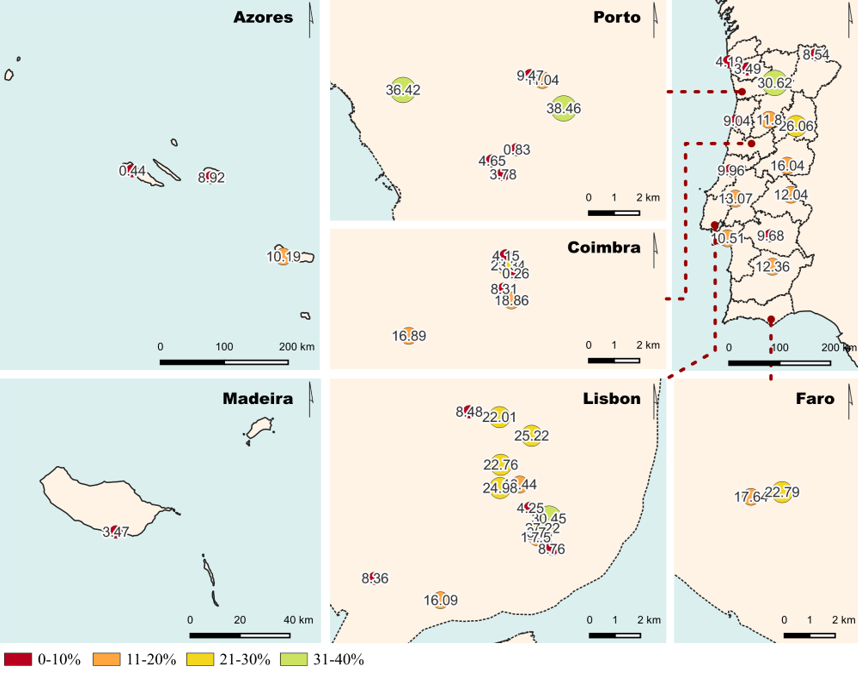
Fig. 5 Tree cover (%) per public hospital campus. Background data: © EuroGeographics for the administrative boundaries; CAOP (Official Administrative Map of Portugal) 2021.
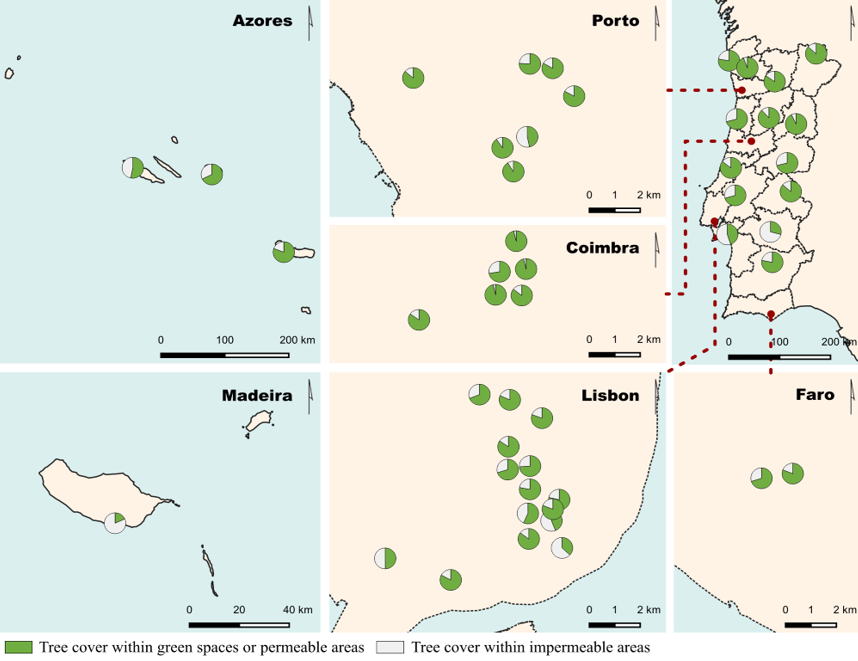
Fig. 6 Percentage of tree cover in green spaces/permeable areas and in impermeable areas. Background data: © EuroGeographics for the administrative boundaries; CAOP (Official Administrative Map of Portugal) 2021.
In addition to the location in green spaces and impermeable surfaces, it was found that the tree cover on the campuses of the public hospitals studied was at a maximum distance of 80-90m from the hospital buildings (figures 7 and 8).
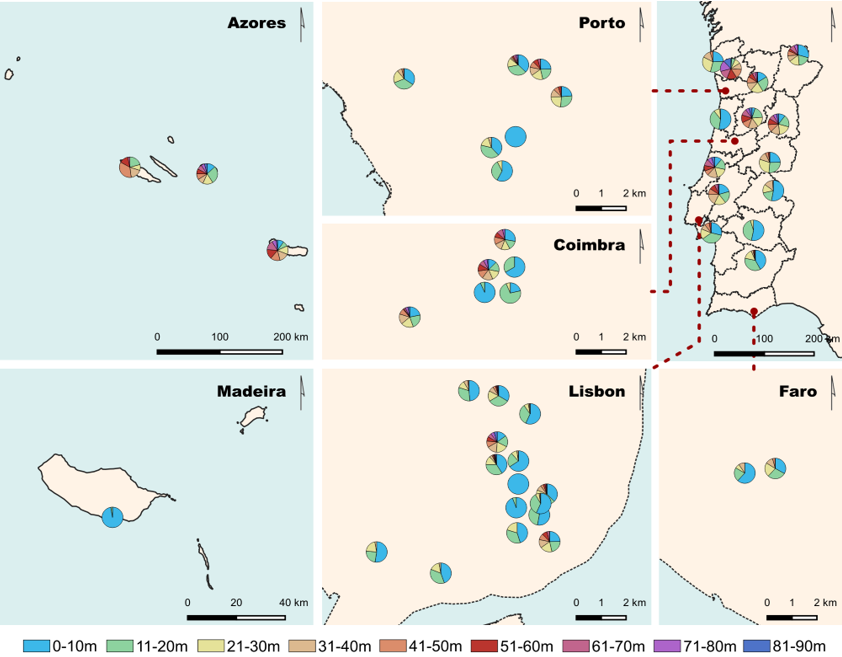
Fig. 7 Distance from buildings to tree cover (% and m²). Background data: © EuroGeographics for the administrative boundaries; CAOP (Official Administrative Map of Portugal) 2021.
Most of the tree cover is close to the hospital buildings, gradually decreasing to a distance of between 81-90m. In part, this was expected due to the size of hospital campuses, which tend to be smaller. However, on some hospital campuses there is also only tree cover between 0-10 m or practically that, not only because these hospital campuses are small, but because their campuses are so occupied by buildings that there is almost no space left for green spaces and trees. These are the cases of the Hospital Central Especializado de Crianças Maria Pia (Porto), the Maternidade Dr. Alfredo da Costa (Lisbon), the Centro Hospitalar do Funchal (Madeira) and the Hospital de Santa Marta (Lisbon). Conversely, there are hospital campuses where tree cover is more or less present in all distance ranges, such as the Hospital de Santa Maria (Lisbon) and the Hospitais da Universidade de Coimbra, where the size of the hospital campuses and the layout of buildings allow it.
Discussion
Most hospital campuses in Portugal lack usable green spaces. The same was also found by Jiang et al. (2018) in their study, who relate that most gardens are used, principally, for viewing purposes. However, green spaces located on hospital campuses have great potential and could contribute to expanding/introducing certain functions and creating new capabilities through the use of hospital outdoor spaces. Furthermore, this is also an opportunity to reconvert spaces that we observed to be mostly disused and many practically abandoned. Thus, with the conversion of these spaces into TG, the hospitals studied would improve patients' quality of life, benefit their families and healthcare professionals and may also accelerate their healing process (Bernez et al., 2018; Hastuti & Lorica, 2020; Jiang et al., 2018; Pimentel, 2023; Reeve et al., 2017; Sherman et al., 2005).
TG in the studied hospitals can also be pleasant places where patients can receive visitors or staff can take a break. However, this requires a major transformation of the 48 public hospital campuses, as most are not even prepared to be used. For example, it is necessary to include resources that allow adults to sit and socialize, elements that allow relaxation through listening to the sounds coming from the movement of water, for example, have circuits that allow patients to walk through the garden, elements or programs that allow children to be involved, since they prefer interactive activities, ensure privacy through plant hedges or similar, as patients prefer (Sherman et al., 2005), and have plants in which patients can feel texture, smell and that have other characteristics suitable for TG.
It was found that most of the area of green spaces on the studied hospital campuses is close to hospital buildings, which makes their conversion into TG viable, since a direct access and a strategic location are imperative features for their success (Hastuti & Lorica, 2020; Jiang et al., 2018; Sherman et al., 2005). For example, Sherman et al. (2005) found that the largest garden which at the same time has more direct access was the most used. Thus, if converted into TG, most of the green spaces in the hospital campuses studied could have the potential to attract more visitors and, consequently, promote more direct contact with nature and greater socialization which, in turn, will benefit the mental health of their users (Chen et al., 2021; Sherman et al., 2005; Song & Lin, 2022).
However, although proximity to TG is important, distant green spaces should not be neglected as they are important for other functions (Bernatzky, 1977; Liu et al., 2023; Ogawa et al., 2023; Wang et al., 2022) and for cities in which, in general, they are scarce and do not reach the recommended values (Fuller & Gaston, 2009; Gómez et al., 2014; Martins & Pereira, 2018), thus can being mainly the largest campuses hospitals, important green space preservation areas in cities. Therefore, not only the green spaces and the permeable areas adjacent to hospital buildings should be subject to improvement and preservation, but also the entire hospital campuses, so that they can perform their functions with the best possible quality.
One of the reasons for the lack of usable green spaces or even TG on hospital campuses may be the lack of knowledge about their advantages. In fact, decision-makers may have seen the surroundings of hospital buildings only as places to frame and beautify the buildings, not realizing their potential, and even though the no usable green spaces in the hospital campuses may also have their advantages, a TG have many more (Bernez et al., 2018; Hastuti & Lorica, 2020; Jiang et al., 2018; Pimentel, 2023; Reeve et al., 2017; Sherman et al., 2005).
Hence, a publicity campaign about TG not only among decision makers but also among the general public could be crucial to reversing this trend. On the one hand, studies on the benefits (or not) of green spaces in Portuguese hospitals, such as those involving patient recovery rates and consequently economic gains, could be important to present to decision makers, so there is a need for the scientific community gets involved. On the other hand, it is also important to directly inform patients, family members and healthcare professionals about the advantages of using a TG. It is equally important to develop more studies and disseminate them to Landscape Architects and Urban Planners, in order to clarify the specific needs of this type of green spaces, as a poor design can compromise their effectiveness (Pimentel, 2023).
Of the seven maternity/paediatric hospitals studied, only four have usable green space and among them, only two have more usable green space than not usable one (Hospital de D. Estefânia and Maternidade Dr. Bissaya Barreto). In addition to the need to increase usable green space on these hospital campuses, there is also the need, in a future study, to assess whether or not the space is suitable for children and to make, if necessary, the required adaptations. More than creating more usable green spaces, the creation of excellent quality TG, with areas to play, should also be considered due to the benefits they provide to children (Pasha & Shepley, 2013; Reeve et al., 2017; Sherman et al., 2005). Furthermore, as children are more vulnerable than adults, children's hospitals should be among the first hospitals to receive intervention.
This study only analysed the usability of green spaces on public hospital campuses, without analysing their quality. However, it does not matter to have usable green spaces if they do not have enough quality to allow the adequate performance of their functions. For example, Pasha and Shepley (2013) found that the quality of garden design in a paediatric hospital can influence children's physical activity. The need for TG certification has also been mentioned precisely for this reason (Marcus, 2016; Pimentel, 2023).
Therefore, in addition to the fact that in a future study it will be necessary to analyse the quality of public hospital green spaces in Portugal in order to ascertain their situation and be able to make the necessary corrections, there is also a need to create a document with specifications for TG in general, but also for specialized hospitals such as hospitals for children and older adults, so that Landscape Architects can develop these spaces properly.
Although there is tree cover on all hospital campuses studied, a low percentage was found in most of them, with some even having almost no trees. These are the cases of the public hospital in Horta, the Hospital Central Especializado de Crianças Maria Pia and the IPO Coimbra, where tree cover less than 1%. Low tree cover can be detrimental to the good performance of TG, since trees are important for therapeutic functions (Alvarado et al., 2023; Feng et al., 2022; Joung et al., 2022; Lee et al., 2023; Paraskevopoulou et al., 2018; Pearson et al., 2023), to provide shade allowing patients, families and healthcare professionals to remain in the garden on hotter days and to provide a visual and sound barrier that can help users to abstract themselves from the city and give a feeling of greater naturalness to the green space.
Therefore, so that public hospitals in Portugal can provide better wellbeing and health conditions and, in addition, can perform therapeutic functions, provide better views for patients and block annoying noise, it is important to increase their tree cover. This is even more crucial to do if we really want to create TG that expand/complement the hospital functions.
In addition to the low tree cover found, part of it is not located in a green area. On the one hand, this is positive, as trees are important for reducing surface temperatures, contributing to mitigating the surface temperature and the urban heat island (Jung et al., 2021; Kaluarachichi et al., 2020; Yan et al., 2023), which could have a positive effect on public hospital campuses. On the other hand, this also means that the percentage of tree cover in green spaces is even lower and consequently the structure of existing green spaces is less solid, which also means that extra effort will be needed if policy makers decide to convert current green spaces into TG.
However, as earlier mentioned, trees on impervious surfaces are also important and should not be neglected during interventions on hospital campuses. Furthermore, from the point of view of mentally influencing patients, they could be equally important, as it was found that street trees, which are in an analogous situation, also have a positive influence (Alvarado et al., 2023). Thus, both situations should exist and complement each other.
Most of the tree cover on public hospital campuses in Portugal is close to the hospital buildings, which is positive, as proximity to trees has been found to be beneficial especially for individuals on deprived and vulnerable groups (Baró et al., 2019; Bernatzky, 1977; Marselle et al., 2020). Furthermore, as TG must have direct access to patients (Hastuti & Lorica, 2020; Jiang et al., 2018; Sherman et al.; 2005) and, among others, proximity is important for this direct access, it is possible to create more consolidated TG in the proximity of hospital buildings in a shorter period of time, that is, the gardens can have some mature trees and all the benefits they provide, without waiting several years for them to be at a more advanced stage of development and therefore at full potential. Of course, direct access implies not only proximity but also ease of access to the space, as even a nearby garden can be difficult to access and use, which compromises its therapeutic functions (Chen et al., 2021; Song & Lin, 2022). In this study we only focus on the first, but it is also important to study the ease of access to future hospital green spaces during their design.
Although the proximity of trees is important, on hospital campuses large enough to support several layers of trees, their distribution over various distances must be ensured. This is important to reduce noise coming from the city, making the space more pleasant (Defrance et al., 2019; Karbalaei et al., 2015; Martínez-Sala et al., 2006; Oliveira et al., 2022). Furthermore, to maximize noise reduction, vegetation should be strategically selected, for example a combination of trees and shrubs and a mix of broad-leaved evergreens and conifers (Defrance et al., 2019; Karbalaei et al., 2015). Even on small hospital campuses, the presence of some trees, even though they do not have the potential to reduce the level of perceived physical noise, can influence psychological well-being (Nguyen & Morinaga, 2023). Notwithstanding, the hospital campuses which are mostly occupied by buildings must be rethought, as they do not have space available for the construction of green spaces and cannot offer these ecosystem services to patients (Hastuti & Lorica, 2020; Murroni et al., 2021; Sherman et al., 2005; Uwajeh et al., 2019; Yeon et al., 2023; Yzoard et al., 2017).
Conclusions
This study analysed the usability of hospital green spaces, the distance from hospital green spaces to hospital buildings and the tree cover on 48 public hospital campuses in Portugal, as a contribution to the study of the viability of converting these spaces into TG.
It was found a lack of usable green spaces on public hospital campuses in Portugal, which requires a greater effort to convert them into TG. However, the need to create these spaces could simultaneously be an opportunity to provide the National Health Service with green spaces more adapted to the hospital context and in accordance with the most recent scientific findings, for example the creation of TG, which in addition to providing various functions like a common garden, they can also be used for therapeutic purposes. We recommend that green spaces on hospital campuses effectively complement hospitals functions or, at least, be adapted so that they can be used, and are not just used as spaces to beautify their surroundings.
Most of the existing green area on the studied hospital campuses, as well as most of the existing tree cover is close to buildings. This facilitates the conversion of these spaces into TG, since proximity, one of the required direct access conditions (Jiang et al., 2018; Hastuti & Lorica, 2020; Sherman et al.; 2005), can be easily ensured, also providing a more mature garden with greater potential in the early years, due to the existing adult trees.
Despite the proximity of tree cover to hospital buildings, it was found that several hospitals have extremely low tree coverage. In fact, tree cover varies between 0.26% and 38.46%. Despite being mostly located in green spaces or permeable areas, there is still a need to increase it. However, the lack of studies on these issues does not allow us to have a point of comparison, nor to concretely assess the situation on the hospital campuses studied.
In some hospital campuses, a large occupation by buildings that left little space for green areas was observed. Considering the importance of green spaces, as well as the complement of hospital functions they provide, we recommend rethinking these campuses.
We found a lack of information for Landscape Architects to design therapeutic gardens, as well as specifications to assess the current state of gardens on hospital campuses. These specifications are even scarcer for TG dedicated to children and older adults, as they present specific needs, which is why we consider being urgent to produce more research on the subject. Subsequently, with that information, it will be possible to conduct a more in-depth assessment of the hospitals specializing in children covered in this study. In addition, due to the vulnerability of children, we suggest that these hospital campuses have priority in interventions.
In general, the variables studied presented a positive scenario. However, there is a need to complete the assessment of hospital campuses with other studies, for example with the quality of current green spaces. We recommend the creation of guidelines that allow to evaluate the quality of gardens on hospital campuses, that considers the specific case of specialized hospitals for children and older adults and allow a comparison among different case studies.
Authors’ contributions
Bruno Filipe Gonçalves Martins: Conceptualization; Methodology; Software; Validation; Formal analysis; Investigation; Data curation; Writing - original draft preparation; Writing - review and editing; Visualization. Frederico Meireles Rodrigues: Conceptualization; Methodology; Validation; Formal analysis; Investigation; Data curation; Writing - review and editing; Visualization.














